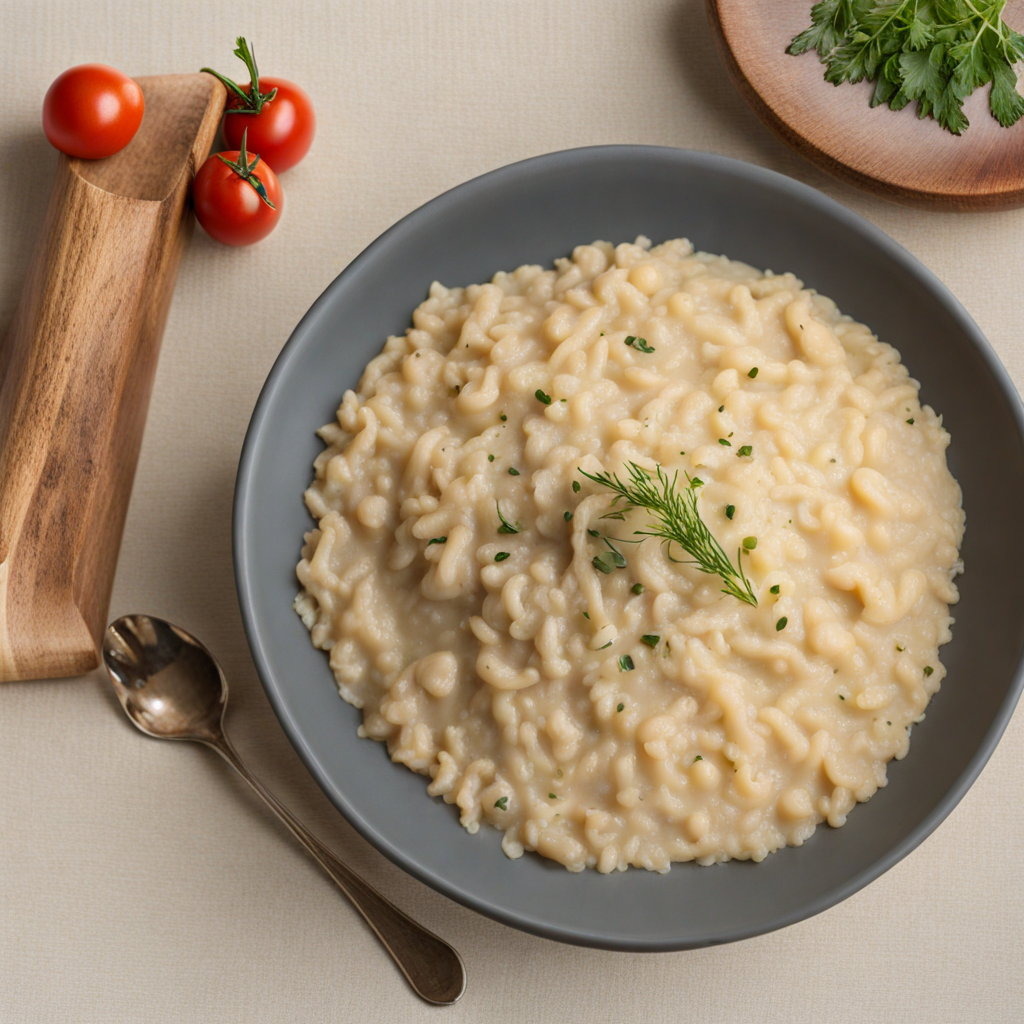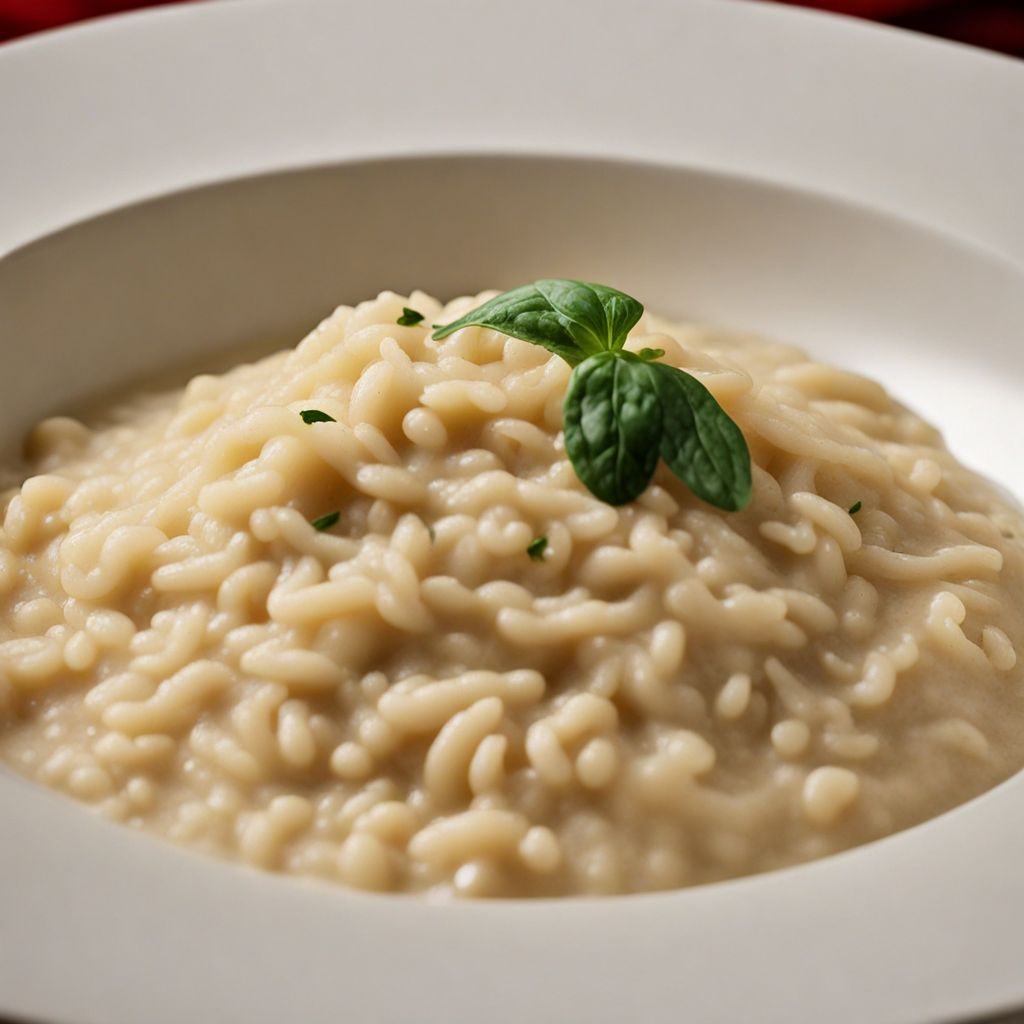Risotto
Risotto is a quintessential Italian dish that embodies the heart and soul of Italian cuisine. Originating from Northern Italy, particularly the rice-growing regions of Lombardy and Piedmont, risotto has a rich history that dates back to the late 19th century. It is believed that the dish evolved from a simple rice preparation, influenced by the culinary traditions of the region and the introduction of rice cultivation by the Arabs during the Middle Ages. Over time, risotto has become a staple in Italian households and fine dining alike, celebrated for its creamy texture and versatility. The flavor profile of risotto is characterized by its rich creaminess and the ability to absorb and meld flavors from various ingredients. The rice, which is the star of the dish, is cooked to a perfect al dente texture, creating a satisfying bite. The dish typically has a savory base, often enhanced with aromatic ingredients such as onions or shallots sautéed in olive oil or butter. As it cooks, the rice releases starch, which contributes to the dish’s characteristic creaminess without the need for excessive cream or cheese. Risotto can be flavored with a variety of ingredients, ranging from earthy mushrooms to sweet peas, and even seafood or saffron, each adding a unique twist to the dish. Preparation of risotto requires patience and attention to detail. The process begins with selecting the right type of rice, with Arborio, Carnaroli, and Vialone Nano being the most common varieties used. These short-grain rice types
How It Became This Dish
The history of risotto is deeply intertwined with the agricultural practices and cultural evolution of northern Italy, particularly in the regions of Lombardy and Piedmont. Evidence suggests that rice cultivation in Italy began in the 8th century, introduced by Arab traders who recognized the fertile plains of the Po Valley as ideal for growing this water-loving grain. The combination of fertile soil, favorable climate, and irrigation systems allowed rice to flourish, leading to its adoption as a staple food. By the 14th century, rice had become an integral part of the Italian diet, particularly in the areas surrounding the city of Milan. It was during this time that the earliest forms of risotto began to emerge. Initially, rice was boiled in water or broth, similar to how pasta was prepared. However, the technique of toasting the rice grains before adding liquid became a hallmark of risotto preparation, enhancing the flavor and texture. This method is believed to have been influenced by the Spanish and their culinary techniques, which had been introduced to Italy during the period of the Spanish Empire. As the dish evolved, the arborio, carnaroli, and vialone nano rice varieties were developed specifically for risotto. These short-grain rice types are known for their high starch content, which is essential for achieving the creamy consistency that characterizes risotto. The unique quality of Italian rice and the specific cooking techniques solidified risotto as a distinct culinary form, setting it apart from other rice dishes around the globe. The cultural significance of risotto in Italy cannot be overstated. It is often seen as a symbol of regional identity, with various regions boasting their own specialties. For instance, Risotto alla Milanese is perhaps the most famous variant, made with saffron that gives the dish its distinctive golden hue. This dish is thought to have originated in Milan in the late 19th century and is often served as a side dish to ossobuco, a slow-cooked veal shank. The use of saffron in this recipe is reflective of the spice trade routes that influenced Italian cuisine in the past. In contrast, risotto in the region of Piedmont often features locally sourced ingredients such as mushrooms, truffles, and wine, particularly the celebrated Barolo or Barbaresco. This reflects the agricultural bounty of the region and its rich culinary traditions. The use of local ingredients not only enhances the flavor but also connects the dish to the landscape and heritage of the area. Throughout the 19th and 20th centuries, risotto continued to gain popularity, both within Italy and abroad. The industrial revolution led to increased urbanization, and as people migrated to cities, traditional dishes began to be adapted for modern kitchens. Risotto became a favorite among the middle class, celebrated for its versatility and the ability to incorporate seasonal ingredients. This adaptability allowed risotto to transition from a simple peasant dish to a refined staple in restaurants and homes alike. The post-World War II era marked a significant turning point for risotto. As Italians emigrated around the world, they carried their culinary traditions with them. Risotto began to gain international acclaim, especially in the United States, where Italian-American chefs started to experiment with the dish, introducing new ingredients and flavors. This led to the creation of innovative variations such as seafood risotto, vegetable risotto, and even risotto cakes. The rise of culinary tourism in the late 20th century further propelled risotto into the global spotlight. Chefs began to explore the dish's potential, attending culinary schools, and experimenting with presentation and flavor pairings. Risotto became synonymous with fine dining, often featured on the menus of high-end restaurants. Chefs would showcase their skills by preparing risotto tableside, allowing diners to witness the cooking process, which added an element of theater to the dining experience. In contemporary cuisine, risotto remains a beloved dish that honors its traditional roots while embracing modern culinary trends. Chefs now explore global flavors, incorporating ingredients from various cultures to create fusion risottos. For instance, one might find risotto flavored with lemongrass and coconut milk or prepared with local seafood and Asian spices, showcasing the dish's versatility. Moreover, the rise of sustainability and farm-to-table movements has influenced how risotto is prepared. Chefs and home cooks alike are increasingly focusing on local, seasonal ingredients to create risotto dishes that reflect the changing landscape of agriculture and the environment. This trend not only honors the dish's origins but also promotes a greater awareness of food sourcing and sustainability. Risotto has also found its way into popular culture, appearing in cookbooks, cooking shows, and culinary competitions, further solidifying its status as a beloved dish. It serves as a canvas for creativity, allowing chefs to experiment while remaining true to the fundamentals—quality rice, a well-crafted broth, and the essential technique of stirring. Today, risotto is more than just a dish; it represents the intricate relationship between food, culture, and history. Its journey from the fields of northern Italy to dinner tables worldwide embodies the resilience and adaptability of culinary traditions. Whether enjoyed in a rustic trattoria in Milan or a chic restaurant in New York, risotto continues to evoke a sense of comfort and connection to the rich tapestry of Italian heritage. The enduring popularity of risotto speaks to its ability to bring people together, celebrating the joy of sharing a meal that is both simple and sophisticated, traditional yet ever-evolving.
You may like
Discover local flavors from Italy







